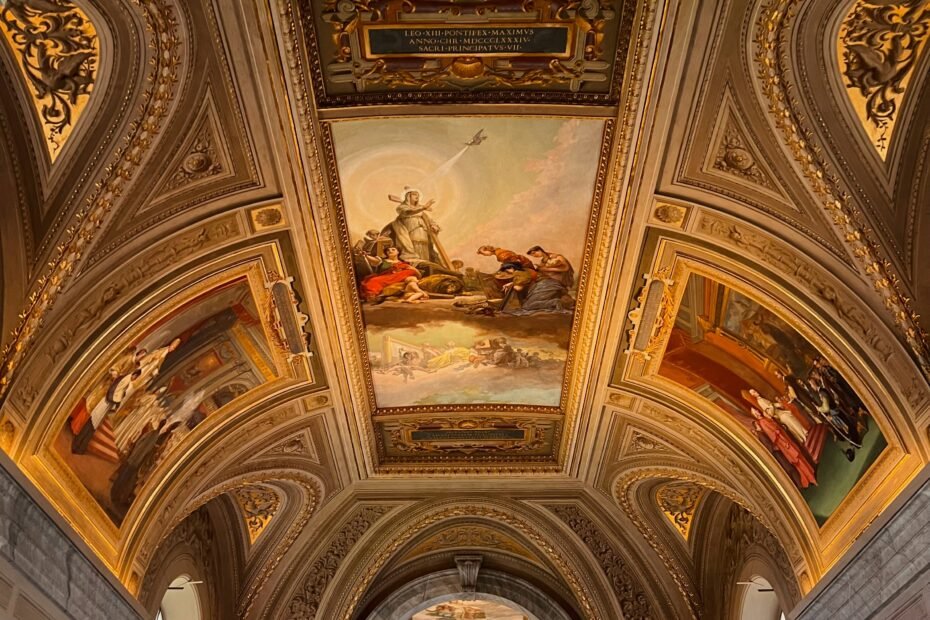The Sistine Chapel (Cappella Sistina), located within the Vatican Museums in Vatican City, is one of the most iconic landmarks in the world. Renowned for its breathtaking frescoes by Michelangelo, it serves as both a religious and cultural treasure. Here’s everything you need to know as a tourist:
Overview
- Location: Vatican Museums, Vatican City.
- Significance:
- Named after Pope Sixtus IV, who commissioned its construction in the late 15th century.
- The official site of papal conclaves, where new Popes are elected.
- Architectural Style: Early Renaissance.
- Key Artists: Michelangelo, Sandro Botticelli, Pietro Perugino, Domenico Ghirlandaio, and more.
Art and Highlights
- Michelangelo’s Ceiling Frescoes (1508–1512):
- Theme: Depicts nine stories from the Book of Genesis, surrounded by prophets, sibyls, and other biblical figures.
- Famous Scenes:
- The Creation of Adam: The iconic image of God’s hand reaching out to Adam’s.
- The Fall of Man and Expulsion from Paradise: A vivid depiction of Adam and Eve’s sin and their banishment.
- Michelangelo painted much of the ceiling while lying on his back on scaffolding, a feat of endurance and artistry.
- The Last Judgment (1536–1541):
- Located on the altar wall, this dramatic fresco by Michelangelo shows Christ’s Second Coming and the final judgment of souls.
- It features over 300 figures, some in dynamic poses that broke with traditional artistic norms of the time.
- Side Walls:
- Frescoes by artists like Botticelli, Perugino, and Ghirlandaio depict scenes from the lives of Moses and Jesus.
- Includes The Delivery of the Keys to St. Peter by Perugino, symbolizing the transfer of authority to the Church.
- The Ceiling’s Architectural Illusion:
- Michelangelo created an illusion of three-dimensional architectural elements, blending painting with architectural detail.
What to Expect as a Visitor
- Atmosphere:
- A reverent and quiet environment, as the chapel is a sacred space.
- Guards enforce silence and prohibit photography or videography inside.
- Entry Process:
- Access is through the Vatican Museums; the Sistine Chapel is typically the last stop on the museum route.
- Expect crowds, especially during peak hours.
Practical Information
- Tickets:
- Entrance to the Sistine Chapel is included with Vatican Museum tickets.
- Prices:
- General admission: €17.
- Reduced admission (students, children): €8.
- Online booking fees may apply (recommended to skip long lines).
- Book in Advance: Tickets can sell out, especially during busy tourist seasons.
- Opening Hours:
- Monday to Saturday: 9:00 AM – 6:00 PM (last entry at 4:00 PM).
- Last Sunday of each month: Free admission but expect large crowds.
- Closed on Sundays (except the last of the month) and Vatican holidays.
- Best Time to Visit:
- Early morning or late afternoon to avoid peak crowds.
- Off-season (November–February) offers a quieter experience.
- Dress Code:
- Modest clothing is required: no shorts above the knee, sleeveless tops, or revealing outfits.
How to Get There
- By Metro:
- Take Line A to Ottaviano or Cipro station, then walk to the Vatican Museum entrance.
- By Bus:
- Routes #49, #492, and #990 stop near the museums.
- By Taxi:
- Accessible from any part of Rome, though traffic can be heavy.
Tips for Visiting
- Plan Ahead:
- The Vatican Museums are vast, so allocate enough time to explore the galleries leading to the Sistine Chapel.
- Hire a Guide:
- A guided tour enhances your understanding of the artwork’s symbolism and history.
- Audio guides are available for a self-paced experience.
- Be Patient:
- The Sistine Chapel is often crowded, especially in high season.
- Combine with Other Vatican Sites:
- Pair your visit with St. Peter’s Basilica and the Vatican Gardens for a full day of exploration.
Nearby Attractions
- St. Peter’s Basilica:
- A short walk away; climb the dome for panoramic views of Vatican City.
- Vatican Museums:
- Explore galleries featuring ancient sculptures, tapestries, maps, and Renaissance masterpieces.
- Castel Sant’Angelo:
- A 15-minute walk from the Vatican, offering stunning views of Rome and the Tiber River.
Fun Facts
- Michelangelo initially resisted painting the Sistine Chapel ceiling, as he considered himself a sculptor, not a painter.
- It took Michelangelo four years to complete the ceiling and another five to paint The Last Judgment.
- The frescoes are cleaned approximately every 30 years to maintain their vibrant colors.
Cultural and Religious Importance
- The Sistine Chapel is central to Catholic tradition and papal history, hosting conclaves where Popes are elected.
- Its artistic and spiritual significance makes it a must-visit for both art lovers and pilgrims.
Conclusion
The Sistine Chapel is a bucket-list destination that offers a unique blend of art, history, and spirituality. From Michelangelo’s awe-inspiring frescoes to its role as a sacred religious site, the chapel is an unforgettable highlight of any visit to Rome. Plan ahead, take your time, and prepare to be mesmerized by one of the world’s greatest artistic achievements.
